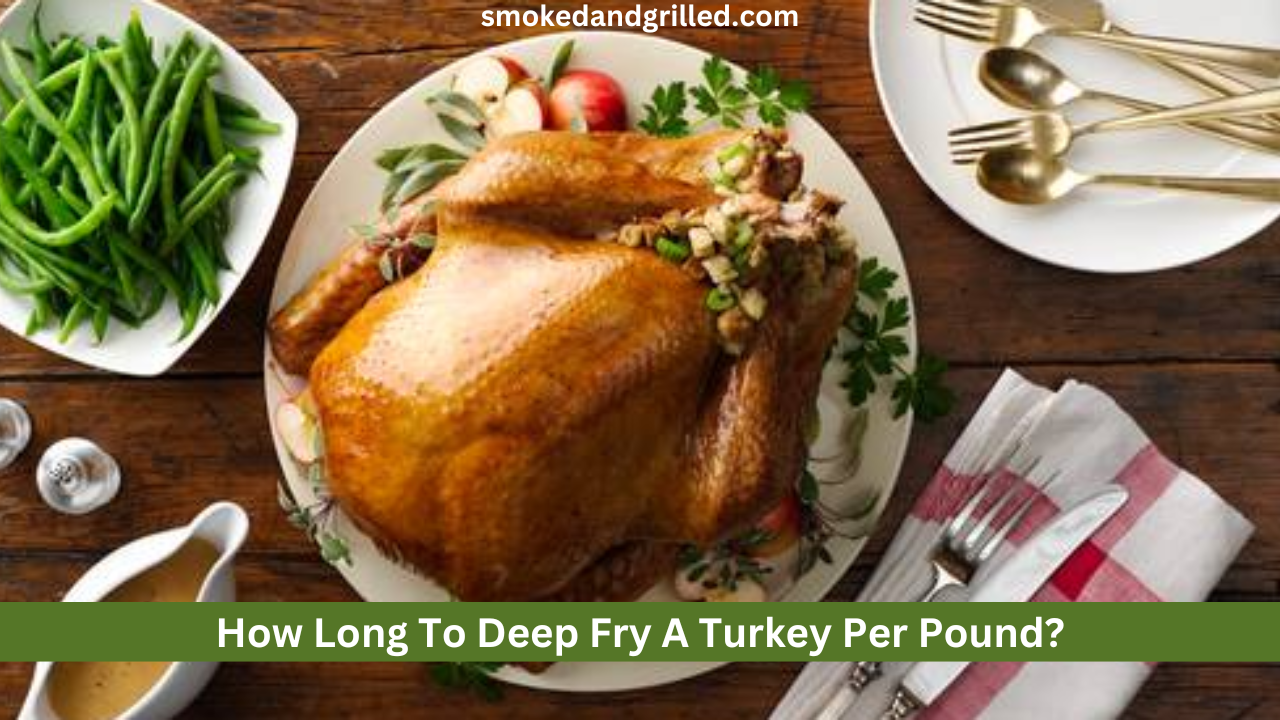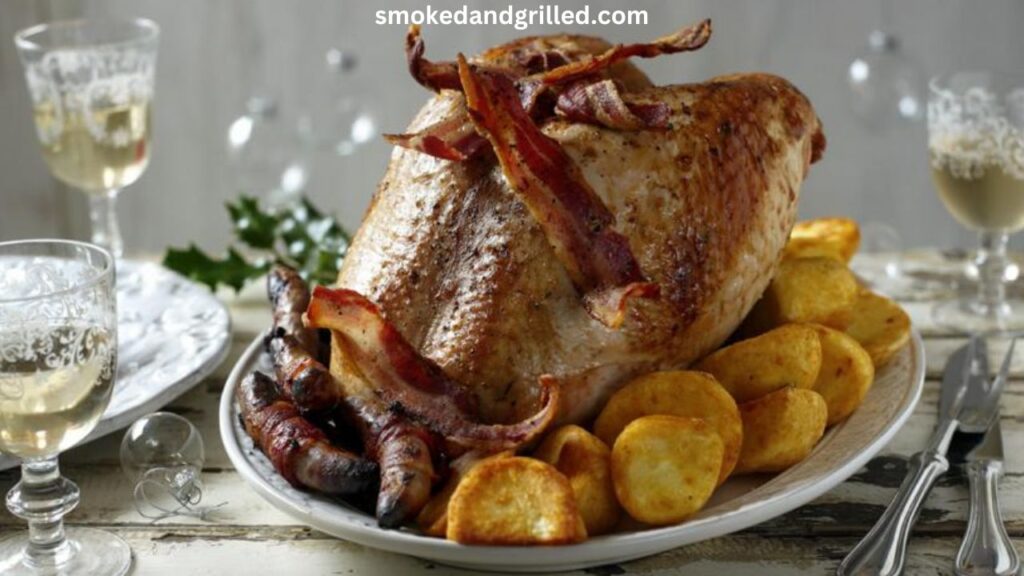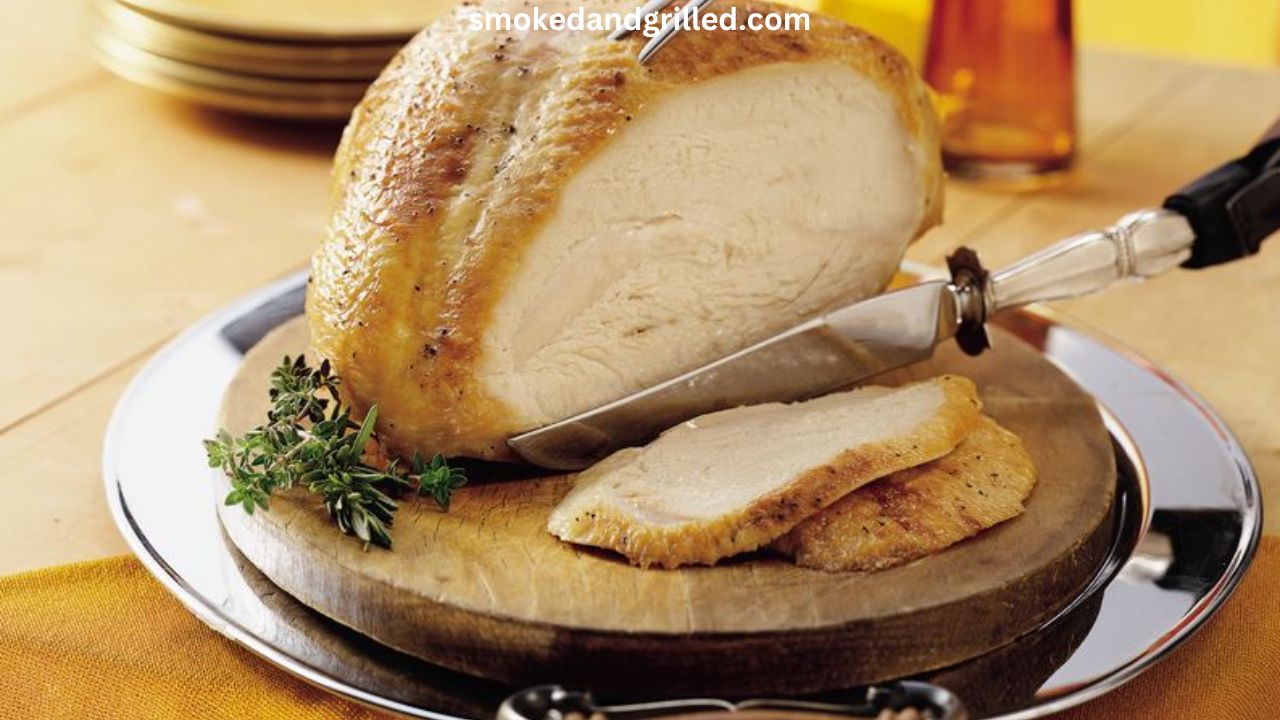Imagine a turkey with a golden, crispy skin that is cooked just right and ready to be eaten. But here’s what every cook is thinking: How long to deep fry a turkey per pound?
Finding that ideal cooking time is crucial to ensure a succulent, juicy bird that leaves your guests begging for seconds.
In this blog, we go deep into the world of deep-fried turkey and figure out how to get the timing just right. So put on your apron and get ready to learn how to make a perfect deep-fried turkey.
Related Posts:
- How Much Oil To Deep Fry A 14 Lb Turkey? (Deep-Frying Success)
- How Long Is Too Long To Brine A Turkey (The Perfect Duration)
- How Long To Smoke A Brisket At 200?- The Ultimate Slow Cook
How Long Should I Deep Fry A Turkey Per Pound?
| Weight of Turkey | Deep Frying Time (at 350°F / 175°C) |
|---|---|
| 8-10 pounds | 40-50 minutes |
| 10-12 pounds | 50-60 minutes |
| 12-14 pounds | 60-70 minutes |
| 14-16 pounds | 70-80 minutes |
| 16-18 pounds | 80-90 minutes |
| 18-20 pounds | 90-100 minutes |
| 20+ pounds | Approximately 5 minutes per pound |
As a general rule, a turkey should be deep-fried for about 3 to 4 minutes per pound.
But it’s important to remember that this is just a rough estimate, and the real cooking time will depend on a number of things.
It’s best to use a meat thermometer to check the temperature inside the turkey to make sure you’re right.
In the thickest part of the thigh or breast, the turkey should hit a temperature of at least 165°F (74°C).
Always put safety first and follow the instructions that came with your deep fryer.
Remember that you have to be patient when deep-frying a turkey if you want the skin to get crispy and the meat to stay juicy.
Is There A Specific Time Guideline For Deep Frying A Turkey Based On Its Weight?
Yes, the weight of the turkey gives you a good idea of how long to deep fry it.
But it’s important to keep in mind that this is just a guess.
Different things, like the type of pan, the temperature of the oil, and the size and shape of the turkey, can change how long it takes to cook.
To ensure precision, always use a meat thermometer to check the internal temperature of the turkey.
In the thickest part of the thigh or breast, it should hit at least 165°F (74°C). To cook a safe and tasty turkey in a deep fryer, you must follow the safety rules and instructions that come with it.
How Does The Cooking Time For Deep Frying A Turkey Vary Depending On Its Poundage?
The amount of time it takes to fry a turkey in oil depends on how much it weighs.
As a rule of thumb, you should cook a turkey for about 3 to 4 minutes per pound.
But it’s important to keep in mind that cooking time is not directly related to weight.
This is because bigger turkeys are heavier, so it takes longer for the heat to reach all parts of the meat.
The form and thickness of the turkey can also change how long it takes to cook.
It’s important to use a meat thermometer to check the turkey’s internal temperature because it’s the best way to tell if it’s done.
Follow all safety rules and the manufacturer’s instructions for your deep fryer to make sure your turkey is cooked perfectly and safe to eat.
Should I Adjust The Cooking Time If I’m Using A Larger Or Smaller Turkey?
Yes, you should change the cooking time based on how big or small your turkey is when you deep fry it.
As a general rule, bigger turkeys take longer to cook per pound, while smaller turkeys may take a little less time per pound.
This change is needed to make sure the turkey is cooked all the way through and gets the right temperature inside.
No matter how big the turkey is, the thickest part of the thigh or breast should hit at least 165°F (74°C) on the inside.
By changing the cooking time based on how much the turkey weighs, you can make sure it cooks properly and safely.
Remember to always prioritize safety and follow the manufacturer’s advice for your specific deep fryer.
Dangers Of Overcooking Or Undercooking A Deep-Fried Turkey
Overcooking or undercooking a deep-fried turkey can both be dangerous and change the taste of the finished dish.
If you cook a turkey too long, the meat can become dry, tough, and tasteless.
If the turkey is exposed to high heat for a long time, it can get too crispy or even burn, which makes it feel and taste bad.
On the other hand, undercooking a turkey can be dangerous as it may leave the meat insufficiently cooked, leading to possible health risks.
Salmonella and other dangerous bacteria can live in chicken that isn’t cooked all the way through.
This temperature kills any germs and makes sure the turkey is fully cooked, moist, and safe to eat. To know for sure when the turkey is done when deep fried, it is best to use a meat thermometer.
Steps To Follow When Deep Frying A Turkey
Yes, there are steps and rules to follow when deep-frying a turkey to make sure the cooking process goes well and is safe. Here’s How-to-do-settl Here’s Here. Here’ Here
The turkey should be completely defrosted and dry before it is fried. Moisture can cause oil splatters.
- Choose a place outside that is safe and away from things that can catch fire.
- Find out how much oil you need and heat it to the right temperature, which is usually around 350°F or 175°C.
- Slowly and carefully lower the turkey into the hot oil using a strong tool like a turkey fryer hook.
- Keep the cooking temperature steady and keep an eye on it throughout the process.
- Cook the turkey for about 3 to 4 minutes per pound, adjusting the time based on the turkey’s weight and using a meat thermometer to make sure it gets an internal temperature of 165°F (74°C).
- When the turkey is done, carefully take it out of the oil and let it sit for a few minutes.
- Cut the deep-fried turkey into pieces and serve it while it’s still hot and crispy.
Be sure to put safety first, follow the instructions that came with your fryer, and wear safety gear like heat-resistant gloves and masks.
What Are The Benefits Of Deep Frying A Turkey Compared To Other Cooking Methods?
Deep frying a turkey offers several benefits compared to other cooking methods, making it a popular choice for many. Here are some reasons why it’s a good idea to deep-fry a turkey:
1- Faster Cooking Time:
When compared to traditional roasting ways, it takes a lot less time to cook a turkey in a deep fryer. This makes it easier to make a tasty turkey in less time, which is especially helpful when cooking for a big group.
2- Crispy Skin:
Deep-frying makes the skin crispy and golden in a way that is hard to get any other way. The hot oil keeps in the juices, resulting in a flavorful and crunchy exterior.
3- Juicy And Tender Meat:
The Rip-cooked Iterity There The T T k : T Peg k. The fast cooking at high heat keeps the turkey from drying out.
4- Enhanced Flavors:
The deep-frying process gives the turkey a unique and delicious flavor that makes your mouth water.
5- Versatility:
Deep-frying lets you get creative with spices and flavors. You can try different marinades, rubs, and flavors that you can put into the meat to make it taste the way you like.
Deep-frying a turkey requires careful attention to safety, but the result is often a tasty, visually appealing showpiece for your meal.
What Should I Do If I Don’t Have A Deep Fryer But Still Want To Fry A Turkey?
If you don’t have a deep fryer but still want to fry a turkey, there are alternative methods you can use. Here’s what you can do:
1- You could use a large pot or kettle on an outdoor propane burner. Make sure the pot is deep enough to cover the turkey in oil completely.
2- Look for a turkey fryer kit that has a stove, a pot, and any other necessary tools. These kits are made just for cooking turkeys and offer a safe and easy way to do it.
3- Another option is using an electric turkey fryer, which removes the need for an open flame and uses electricity to heat the oil.
4- You could use an oil-less turkey fryer that cooks the turkey with infrared heat. This method makes the outside just as crispy without using oil.
Remember to always follow the advice and safety rules that the equipment’s maker gives you.
Make sure there’s enough airflow, keep a fire extinguisher close by, and keep a close eye on the cooking to make sure it’s safe and tasty.
Can I Stuff The Turkey Before Deep Frying It, Or Should I Remove The Stuffing?
You shouldn’t stuff a turkey before you deep fry it. Deep-frying may not let the stuffing reach a safe internal temperature because of the high heat and short cooking time.
This makes it more likely that germs will grow and cause foodborne illnesses.
To make sure the food is safe and cooked evenly, it’s best to take out the stuffing and cook it on its own.
If you like the taste of stuffing, you might want to make a different batch in a baking dish or casserole and serve it with the deep-fried turkey.
So, you can enjoy both a juicy, tasty turkey and a deliciously cooked stuffing without sacrificing safety.
FAQs
What Is The Healthiest Oil To Deep Fry A Turkey In?
Peanut oil is the best oil for deep-frying turkey because it has a high flash point and is less likely to catch fire.
Peanut oil is also low in saturated fat, which helps make the fried turkey dish healthy.
How Long Does It Take To Heat Up The Oil?
To keep oil from getting too hot, you should try not to rush through the process of making it.
The best way to heat the oil is to put it on a stove set to medium heat.
At this setting, it should take about 5 to 10 minutes to reach the right starting temperature.
What Is The Best Seasoning For A Deep-Fried Turkey?
The best way to season a deep-fried turkey varies a lot on personal taste, but a dry rub or a mix of herbs and spices are two popular choices.
A standard seasoning blend often includes salt, pepper, garlic powder, onion powder, paprika, and dried herbs like thyme, rosemary, and sage.
For a spicy kick, you can also try Cajun or Creole seasonings or make your own mix.
Before deep-frying the turkey, it’s important to season it heavily on the outside and inside as well.
This will make it taste better.
How Do I Dispose Of The Used Oil?
Used oil needs to be thrown away in the right way to protect the earth and keep people safe.
Once the oil has fully cooled, pour it into a strong container that can be sealed, like a jar or a plastic bottle.
Don’t pour the oil down the drain because it can clog pipes and hurt the environment.
Find out how to get rid of cooking oil in your area by calling your local recycling or trash center.
Used cooking oil can be dropped off at marked places or recycled through programs in many communities.
You can also use the oil again or give it to a group that accepts used cooking oil for a variety of reasons.
Does Frying A Turkey Taste Better?
When you fry a turkey, it can turn out tasty and tasty.
Deep frying at a high temperature makes a golden, crispy skin that seals in the juices, making the meat soft and moist.
The frying process gives the food a special flavor and texture that many people like.
But people have different tastes, and some may like the traditional taste of roasted turkey.
In the end, whether cooking a turkey tastes better or not is a matter of personal taste and what you want to happen.
Conclusion
In conclusion, the best way to make sure the turkey at the center of your holiday meal is juicy and perfectly cooked is to learn how to deep fry it by the pound.
By knowing the recommended cooking times based on the weight of the turkey, you can get that perfect mix of crispy skin and moist, tender meat.
Remember to put safety first, follow the instructions from the maker, and use a meat thermometer to know when the meat is done.
Whether you’ve been deep-frying for years or this is your first time, the expectation and delicious results make it all worth it.
Also Read:



